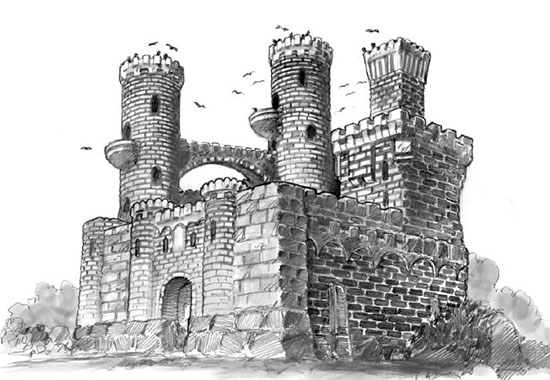
SESSION 20F: THE GHOST APPEARS
April 27th, 2008
The 9th Day of Kadal in the 790th Year of the Seyrunian Dynasty
Heading back out into the hallway they went to the last door on the second level. This was another iron door and it led into one of the small towers that flanked the front gate. A ladder bolted to the wall led up to the next level of the tower.
Tee and Tor climbed up the ladder. Tor headed through another iron door, this one leading to the gatehouse immediately above the entrance to the house: They could see where a large stone block had been levered out of the floor and pushed to one side, revealing the murder hole the ratlings had attacked them through. A narrow wooden table off to one side held the decrepit remains of four crossbows and three quivers of rotten quarrels, all covered with cobwebs and dust. An iron pot filled to the brim with rusty caltrops was shoved into a far corner. There was a matching door directly opposite.
Tor proceeded cautiously into the gatehouse. He hadn’t gone more than a few steps, however, before the door suddenly slammed shut behind him. Tee jumped for it and easily got it open again. She turned and called over her shoulder, “Get up here! Something’s happening!”
The trapdoor slammed shut.
“Tee?” Elestra called. “What’s happening?”
Tee whirled back towards Tor… just in time to see the ghost materialize between them.
The spirit wore the robes of an Imperial priest, but its face was contorted with fury. “Leave this place! The curse will claim your souls!”
Tee hesitated for a moment and then leapt for the trap door, yanking it open. “Agnarr! The ghost is right here!”
Tor, meanwhile, had drawn his sword and – with a single quick swing – sliced it through the ghost’s ethereal form. Although the blade crackled and its electrical arcs flashed as it passed through the ghost, the apparition appeared unphased.
Agnarr began clambering up the tower ladder. Dominic, thinking quickly, ran back around the hall to a window looking out over the courtyard. Through this he was able to look up through one of the inner arrow slits of the gatehouse and see the ghost moving menacingly towards Tor.
Dominic raised his holy symbol and called out a prayer to Athor. But whether it was the distance, the thick stone walls, or the sheer tenacity of the spirit the prayer had no effect. Frowning, Dominic ran back around towards the ladder.
Tor swung his sword again… again to little effect. But at the blow the ghost’s face was transformed into a black maw of rage “YOU HAVE BEEN WARNED!”
Every object in the gatehouse began to shake violently, and then handfuls of the sharp, rusty caltrops came flying out of their cauldron – pelting Tor viciously.
Agnarr leapt out of the trapdoor and drew his sword, bounding towards the door leading to the gatehouse. “FOR THE GLORY!”
The spirit whirled: “LEAVE THIS PLACE.”
Agnarr grunted and swung his flaming sword. It ripped through the ghost, and Agnarr could feel it catching and tearing.
The ghost moaned in pain and rushed away from Agnarr… passing straight into Tor’s body.
Tor jerked spasmodically, and then a clearly alien intellect took possession of his limbs and spoke through his lips: “Leave this place or your friend will die.”
Agnarr paused. “I’ll only give you once chance: Get out of his body.”
“LEAVE THIS PLACE!”
Agnarr attacked. The spirit clumsily raised Tor’s sword and parried the attack. Agnarr moved to attack again, but the ruined crossbows were swept off their table and hurled at Agnarr by invisible hands.
Agnarr stumbled under the assault, and barely got his sword back into a defensive position as “Tor” attacked him. Agnarr parried several more attacks, trying to figure out some way of getting rid of the ghost without harming Tor. But there didn’t seem to be any way around it.
“I’m sorry, Tor! Dominic will heal you later!” Agnarr got ready to swing away with all his strength, which would surely sweep aside the ghost’s clumsy defense—
When Dominic, having ascended the ladder behind him, raised his holy symbol and with a shouted prayer focused his faith upon Tor’s body. The ghost was blasted back, forcibly ripped from Tor’s soul, and then faded into wispy nothingness…
“Is it gone?” Tee asked.
Dominic gasped. “I think so.” (more…)















